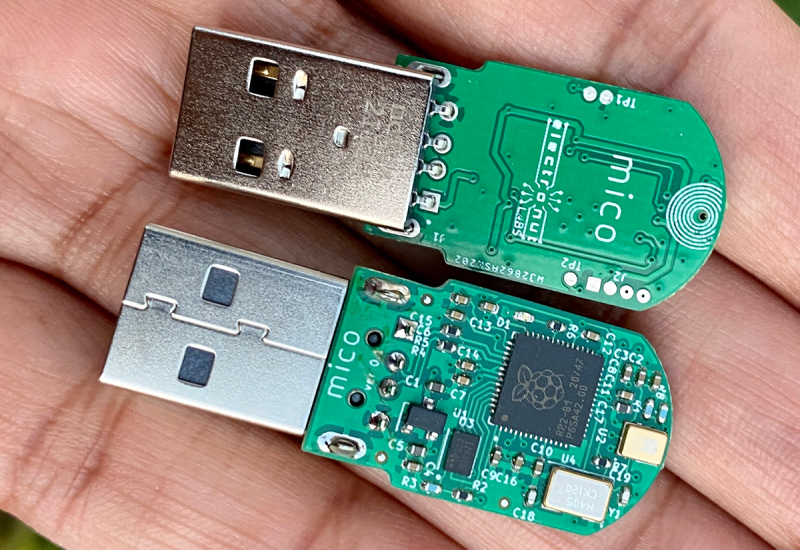When [Mahesh Venkitachalam] was experimenting with machine learning for audio applications on a Raspberry Pi, he found himself looking for a simple USB microphone. A cheap one was easy to find, but the sound quality and directionality left much to be desired. A large, studio-quality mic would be overkill, so [Mahesh] decided to simply build exactly what was needed: a compact, yet high-quality USB microphone that he called Mico.
The sensing device is a MEMS microphone that outputs a pulse density modulated (PDM) signal. There are chips available to directly interface such a microphone to a USB port, but [Mahesh] found them difficult to work with and therefore settled on something he knew already: the Raspberry Pi Pico platform. Luckily, someone had already figured out how to read out a microphone and present a USB device to a PC, so all that was needed was to put all the bits together into a convenient form factor.
The great thing about the Pico platform is that its main controller chip, the RP2040, is available as a separate component. [Mahesh] designed a sleek little PCB that holds the RP2040 along with the MEMS microphone and a USB connector. The end result looks tidy enough that it might have come out of a mass-produced gizmo. Those don’t usually come with full schematics and source code, but the Mico does: everything is available on its GitHub page for anyone to re-use and improve.
You can judge the sound quality for yourself in the video embedded below. If you like DIY USB microphones, you’re in luck: we’ve featured one based on an STM32 as well as a beautiful recreation of a studio-quality mic.















Nice. Very slick.
Fantastic. You could also theoretically do inline audio processing on the Pi before it hits the USB interface.
Thinking the same thing. Trigger word or ‘clapper’ with keyboard emulation macros would be cool :)
https://blog.tensorflow.org/2021/09/TinyML-Audio-for-everyone.html?m=1
This post covers a lot of WHAT I guess you would want.
Sorry, phone decided to capitalise “what”, making me look like a prat.
Oooo lovely. I have a carrier board in the parts bin. Thank you :)
@ScriptGiddy I wonder if a Maix-Bit wouldn’t be your friend here: maire memory, on board mic, and hardware FFT & conclusions. Just a thought.
I was thinking voice morphing on the go applications, like in a mask.
Speaking of:
https://colab.research.google.com/github/alievk/avatarify/blob/master/avatarify.ipynb
It is amazing how much you can do with such a small piece of hardware, not only does it work as a USB mic but also as an audio converter for your phone or tablet! It doesn’t need any software or drivers to be installed on your PC or Mac, just plug in the USB cable between the device and your computer (which should have been done before). You don’t even need to install anything on your mobile device because all you will hear is what comes out from the mic itself. The sound quality seems really decent too which makes me believe that it has some built-in equalizer
And when will this be popular on Tindie ?
I was scanning/perusing Tindie yesterday, and noticed one seller is on break until December 31st, 2030!
B^)
What have we gained here? A custom PCB with a fairly fancy (even if cheap) fancy MCU and an audio interface that connects to a microphone, that serves to make a microphone work with a USB host??
I get a simpler microphone interface from a $8 genuine Apple device. I don’t like Apple, but it came to my door for about $8, and sources say that it measures well. They sell them for iPads. (And the DAC is really good, too.)
Yeah Apple, the company known for open source and open hardware. /s
This hack here is a million times better than anything “Apfel”.
very good. I’m waiting for 2 or 3 mic for mycroft assistent
I have a simple test benchmark this device. If You are a autor please send maxium data trought this microphone, for example using http://www.whence.com/minimodem/ program. (or any other)
If you think making something is a waste of time, your reading the wrong website.
Ever since I started commenting “Don’t feed the trolls!”
I’ve noticed fewer responses to my comments.
B^)
I have found that cheap USB microphones perform very well, far better than Mahesh’s documented experience. That mystery is worth solving given that both microphones appear identical. I mean literally no noise and with enough processing of the signal you can pick up people talking meters away. I guess I will have to pull a few of the ones I have apart and see what actual components they are using.
Would like to know how this is considered a “studio quality” mic.
I could see something like this being used for wiretapping.